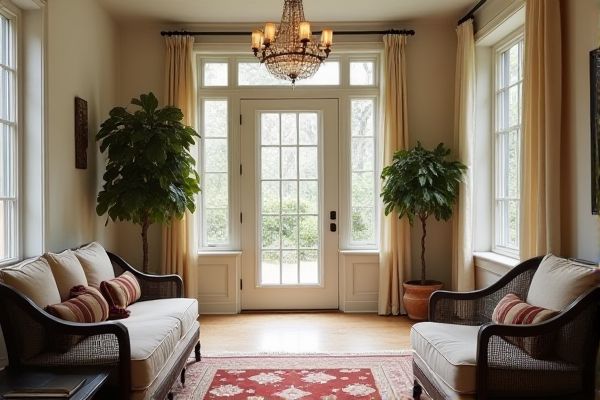
A vestibule is a small entryway or antechamber designed to act as a buffer between the outdoors and the interior of a home, often providing insulation and reducing heat loss. Understanding the differences between a vestibule and an enclosed porch can help you choose the best design for your home's functionality and aesthetic; keep reading to explore which option suits your needs.
Table of Comparison
| Feature | Vestibule | Enclosed Porch |
|---|---|---|
| Definition | Small entry space between exterior door and interior. | Porch area fully enclosed with walls and windows. |
| Primary Function | Acts as a transitional buffer to reduce heat loss and control airflow. | Provides additional living or sitting space protected from weather. |
| Size | Compact and narrow, just enough space for door area. | Larger, often extends as an outdoor room. |
| Location | Located immediately inside the main entrance. | Attached to the exterior side of a home. |
| Construction | Simple walls, often insulated, with interior and exterior doors. | Fully finished walls, windows, sometimes heating or cooling. |
| Usage | Used for controlling temperature, removing shoes, coat storage. | Used as a sunroom, relaxation area, or extra living space. |
Understanding the Vestibule: Definition and Purpose
A vestibule is a small, enclosed entryway that serves as a transitional space between the outdoors and the interior of a building, helping to reduce heat loss and improve energy efficiency. Unlike an enclosed porch, which is often larger and designed for relaxation or socializing, a vestibule primarily functions as a buffer zone to prevent drafts and keep your home's temperature stable. Understanding this distinction can help you optimize your home's design for comfort and energy savings.
What Is an Enclosed Porch? Key Characteristics
An enclosed porch is a space attached to your home, fully surrounded by walls and fitted with windows or screens, offering protection from the elements while maintaining outdoor views. Unlike a vestibule, which serves primarily as a small entryway for transitioning between outdoors and indoors, an enclosed porch provides a larger, more versatile area for relaxation or socializing. Key characteristics include weatherproofing, comfortable seating space, and often, accessibility to the main house interior.
Vestibule vs Enclosed Porch: Key Differences
A vestibule is a small, enclosed entryway that acts as a buffer between the outdoors and the interior, often designed to improve energy efficiency by reducing heat loss. An enclosed porch is typically a larger, more open space with windows and screens, providing a comfortable area to enjoy outdoor views while being sheltered from the elements. Understanding these key differences helps you choose the best option for your home's climate control and lifestyle needs.
Benefits of Adding a Vestibule to Your Home
Adding a vestibule to your home enhances energy efficiency by creating a buffer zone that reduces heat loss and minimizes drafts. This architectural feature improves indoor air quality by limiting the entry of dust and pollutants compared to an enclosed porch. Vestibules also increase home security by providing an additional layer of protection before entering the main living space.
Advantages of an Enclosed Porch
An enclosed porch offers enhanced weather protection, allowing homeowners to enjoy fresh air without exposure to rain, wind, or insects. It provides additional insulated space that can improve energy efficiency and serve as a versatile living area for relaxation or entertaining. The enclosed design also increases home security and can boost property value by expanding usable square footage.
Design Options for Vestibules
Vestibules offer versatile design options including custom-built glass enclosures, insulated walls for energy efficiency, and integrated storage solutions like benches or coat racks. These designs enhance thermal separation between outdoor and indoor spaces while providing an inviting transition area. Unlike enclosed porches, vestibules are typically smaller, more enclosed, and designed primarily for function rather than leisure.
Enclosed Porch Style Ideas
Enclosed porch style ideas include using large windows to maximize natural light while providing protection from the elements, creating a comfortable transitional space between indoors and outdoors. Incorporating weather-resistant materials such as vinyl or composite wood enhances durability and low maintenance. Adding cozy seating, potted plants, and soft lighting transforms an enclosed porch into a versatile area for relaxation and entertaining.
Energy Efficiency: Vestibule vs Enclosed Porch
A vestibule provides superior energy efficiency by acting as an insulating buffer zone that minimizes heat transfer between the interior and exterior, effectively reducing heating and cooling costs. Enclosed porches, while offering some protection against drafts, often have less insulation and more exposure to external temperatures, leading to greater energy loss. Choosing a vestibule with properly sealed doors and insulated walls enhances energy conservation compared to most enclosed porch designs.
Cost Comparison: Vestibule vs Enclosed Porch
A vestibule typically costs less than an enclosed porch due to its smaller size and simpler construction, often ranging between $3,000 to $10,000 compared to $10,000 to $30,000 or more for an enclosed porch. Your budget is impacted by factors such as materials, insulation, and design complexity, with enclosed porches requiring more substantial framing and weatherproofing. Choosing between a vestibule and an enclosed porch involves balancing cost efficiency with functional space needs and aesthetic preferences.
Which Is Right for You: Vestibule or Enclosed Porch?
A vestibule offers a small, enclosed entry space that provides insulation and energy efficiency by reducing heat loss when entering or leaving your home. An enclosed porch creates a larger, versatile area that can serve as a relaxing indoor-outdoor space while protecting against weather and insects. Your choice depends on prioritizing energy savings and compact entry functionality versus enhanced living space and comfort.
 homyna.com
homyna.com